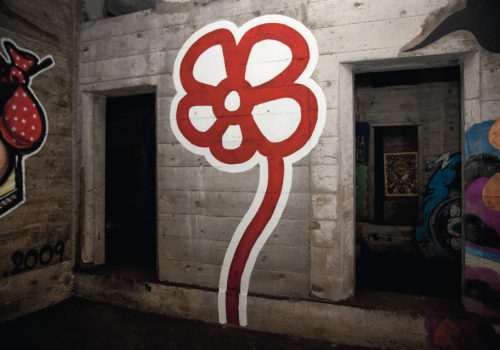New York City is a small town. It just so happens that when you fall into one circle, you get around. And so it is that I interviewed a photographer some time ago to speak about his work taken in abandoned buildings. And as we spoke he mentioned something I did not expect. It was he who inadvertently lead the way for The Underbelly Project.
The photographer is not named in the book’s introduction but described as the stranger who brought PAC into the abandoned train station that would become home to the greatest installation the world has never seen. Collected for the first time in We Own the Night: The Art of the Underbelly Project (Rizzoli International Publications), curators Pac and Workhorse, in conjunction with Emeht Agency, have created a magnificent volume showcasing a form that has become the darling of the art world. That form is street art, which holds tremendous appeal for its ability to be at once both anti-authoritarian and commercially viable at the same time.
The curators amassed a group of 103 current practitioners of the form and invited them to paint in this abandoned train station. The artists, who include some of the medium’s biggest names, including Swoon, Faile, Revok, and Ron English, among many others, were invited to paint in the station between March 2009 and August 2010. Throughout the process of installing these pieces, photography was used to capture what would never be seen by the masses.
As Jim and Tina Darling, the first two artists to pain in the Underbelly, observed, “The station was much larger than we’d imagined. It looked like an industrial version of an orchard with its rows of concrete and steel beams stretching on forever and fading into darkness. The air had a mildewed, metallic taste and was thick enough to see in our lights. As we walked through different platforms and areas, the temperature would rise and drop around each corner. It was like a tomb.”
As it is with any form of illegal art, the ephemeral nature of the form is part of its je ne sais quoi. It becomes the thing you must catch, and if you miss it, all that remains is the photograph. And so it is that what remains of the original is the reproduction, and the photograph becomes not only the artifact but a form of art by proxy.
We Own the Night uses photographs and text to bring us into a world that many would love to enter, had they been given an invitation to do so. Being forward thinking, the curators documented everything so that the end result of their efforts would be the book, the marker, the memento of what is now but a memory in the minds of few. And it is through these images and the stories that we can experience what was an incredible display of talent, recalling at once a time when New York City was covered in graffiti. For though the police have ensured that the trains run clean and that vandals are prosecuted to the fullest extent of the law, the urge to mark territory remains.
We Own the Night is a magnificent catalogue of this exhibition, organized chronologically by the order in which each artist went down to paint in the tunnels, showcased in photographs taken by James H. Garrett III, Ian Cox, Shane Perez, Eric Haze, Emile Souris, Luna Park, Workhorse, and Pac. Each photographer’s style is as distinctive as the artists they documented. The result is a multiplicity of perspectives that changes with each turn of the page, and just as a walk through the tunnels would reveal each art work in its own distinctive way.
But what makes We Own the Night remarkable is the way in which this multiplicity lends itself to the medium of the book. The book, which has a certain permanence and inspires a kind of reverence that few things do, is the perfect space in which The Underbelly Project can exist in the lives of those who want to be a part of something bigger than themselves. The book, which is the ultimate form of art in the age of mechanical reproduction, becomes both an artifact of the exhibition as well as the personalized object. It sits on the shelves of each individual, part of a larger collection of stories that define its owner. And here The Underbelly Project shall live in a kind of eternity, loved by those who champion street art and art books for the way in which they complement each other.
















